- Volume 66 , Number 1
- Page: 70–8
News and notes
This department furnishes information concerning institutions, organizations, and individuals engaged in work on leprosy and other mycobacterial diseases, and makes note of scientific meetings and other matters of interest.
1997 DAMIEN-DUTTON AWARD
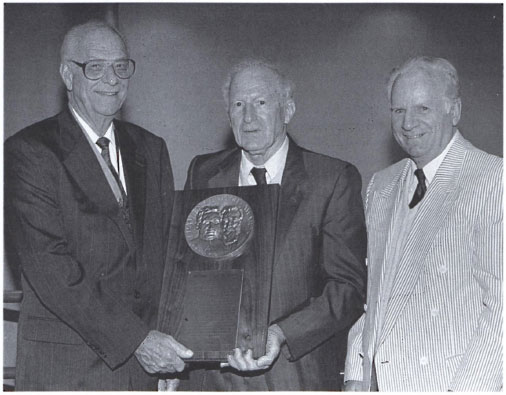
Roy E. Pfaltzgraff. M.D., receives the 1997 Damien-Dutton Award plaque from Wayne M. Meyers. M.D., as Howard E. Crouch. President, Damien-Dutton Society, looks on.
On 13 October 1997 Roy E. Pfaltzgraff, M.D., was presented with the 1997 Damien-Dutton Award for his work with the victims of leprosy in Nigeria.
Dr. Pfaltzgraff of Lancaster, Pennsylvania, became deeply interested in Christian Missions - more specifically, in becoming a medical missionary. To this end he attended Elizabethtown College, obtaining the Bachelor of Science degree in 1938, and Doctor of Medicine from Temple University School of Medicine in 1942. Dr. Pfaltzgraff and Violet Hackman were married in 1942. He interned at Lancaster General Hospital (1943-1944), and was Chief Surgical Resident at Protestant Episcopal Hospital in Philadelphia (1944-1945).
Dr. Pfaltzgraff was ordained to the ministry in 1945, and he, his wife and their first son departed for Nigeria soon thereafter. Their first post was in the Lassa area where Dr. Pfaltzgraff was a part-time pastor and physician at the local dispensary while directing the construction of the Lassa Hospital. Another son came along about this time, and over the years there were five children.
The Pfaltzgraff family was next assigned to the Adamwa Provincial leprosarium at Garkida in Nigeria where they remained until 1982. During this time Dr. Pfaltzgraff developed a highly effective and widely recognized program for the treatment of leprosy patients and the training of physicians and paramedical workers in the management of leprosy. This program included the development of satellite treatment centers and ambulatory services. During much of this period Dr. Pfaltzgraff served as Chief Consultant Leprologist to the Nigerian government in Gongola State. While on furlough in 1964 he was Chief of Rehabilitation at the National Hansen's Disease Center of the U.S. Public Health Service, Carville, Louisiana.
In recognition of his very significant contribution to the management of leprosy in Nigeria, Dr. Pfaltzgraff was given a professorship and awarded an Honorary Doctorate of Science by Ahmada Bello University, Nigeria, in 1982.
On returning to the United States from Nigeria, Dr. Pfaltzgraff was appointed a Medical Consultant for the American Leprosy Missions by Mr. Roger Ackley (President of ALM). He continued in this position until 1991 when he retired. While with the ALM he produced many teaching aids for leprosy workers, and conducted numerous overseas training sessions for physicians, nurses and other paramedical workers. These materials and the hands-on teaching seminars were widely acclaimed and much appreciated, e.g., the Republic of The Philippines awarded him a Citation for Dermatologic Research and Training in 1983.
Dr. Pfaltzgraff is known especially for his expertise in the clinical manifestations and diagnosis of leprosy, and is equally expert in the various facets of physical rehabilitation of the disabilities of leprosy. He has devised many innovative prostheses (braces, shoes, etc.) using appropriate technology for the developing world.
Over the years, Dr. Pfaltzgraff submitted many valuable and well-documented biopsy specimens from leprosy patients to the Leprosy Registry at the Armed Forces Institute of Pathology (AFIP), Washington, D.C. These have added greatly to the usefulness of the teaching files of the AFIP. This is only one very small facet of the many contributions that Dr. Pfaltzgraff has made and continues to make to the community of leprosy workers and the patients they serve. Dr. Pfaltzgraff's recent item in the International Leprosy Association Forum, "What is the Future of Leprosy Care in Light of Decreasing Prevalence and Incidence," was most provocative and typical of his incisive thinking on current issues.
The Damien-Dutton Award is given annually to a person or a group of persons who have made a significant contribution to the conquest of leprosy, either by direct patient care, research, education, social rehabilitation or philanthropy.
Previous Recipients of the Damien-Dutton Award
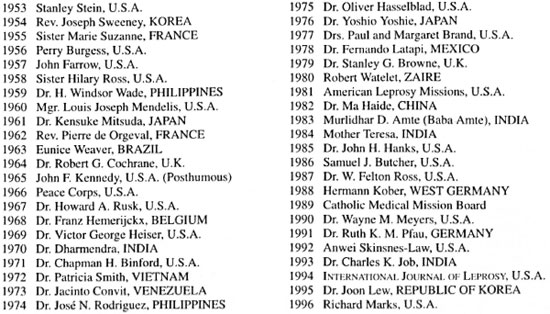
France. ALLF second bulletin published. In November 1997 the Association des Leprologues de Langue Française (ALLF) published the second issue of "le bulletin." It contains articles on the epidemiology of leprosy in the world, in Madagascar, Maroc, Senegal and New Caledonia. Also included is information on surgery in leprosy in 1997 by Pierre Bourrel, surgery for the prevention of deformities and physical rehabilitation of leprosy patients by M. Y. Grauwin and an overview of what was new in leprology in 1997 by Pierre Bobin.
The following is a message from the ALLF President Henri Asse:
"C'est avec une grande joie que nous publions ce deuxième numéro du Bulletin de l'ALLF. Signe de la vitalité de notre association, ce second bulletin est aussi la marque du grand intérêt que vous accordez à l'ALLF car vous avez répondu, nombreux, à l'appel lancé dans le premier numéro. Nous pourrons ainsi mettre à la disposition de tous un bulletin plus riche, plus conforme à l'esprit que l'ALLF veut véhiculer vers et à travers ses membres. Notre voeu serait d'ouvrir un dialogue avec tous ceux qui oeuvrent à l'élimination de la lèpre et, si ce bulletin pouvait être lu dans chaque centre de santé, nous aurions gagné une bataille.
"Tous, contre la lèpre, restons éveillés."
For further information about ALLF or subscription to "le bulletin," contact: Dr. Piere Bobin, Secretary General, ALLF, 4 Rue Jean-Jacques Bal, 3300 Bordeaux, France.
Germany. Commemoration of first International Leprosy Conference. With the first International Leprosy Conference in Berlin 100 years ago, the era of the scientific fight against leprosy started. The German Leprosy Relief Association (DAHW) and the Max Planck Institute for Infectious Biology commemorated the event on 14 October 1997.
"Leprosy is not a punishment from God, but a disease caused by a bacteria!"
Almost 125 years have passed since the Norwegian researcher Armauer Hansen set this scientifically founded counterpoint against commonly held beliefs. Exactly 100 years ago the first International Leprosy Conference in Berlin gave worldwide recognition to the research work of Hansen. The Conference initiated the end of an era which for thousands of years had been marked by helplessness in the face of leprosy.
The first Conference was held from 11-16 October 1897 and was attended by 155 lecturers and delegates from 30 countries, among them Rudolf Virchow, Armauer Hansen and Robert Koch. The Conference set a landmark in scientific discourse about infectious diseases and Berlin, one of Europe's outstanding medical centers, was the ideal host.
Although today the number of leprosy patients is declining scientists attending the commemorative event in Berlin this year were concerned to impress that the disease has yet to be conquered. Though efficient drugs are now available, problems, often caused by governments or society, prevent the effective cure of the disease. "Leprosy is not a tropical disease, " said Dr. Jürgen König, Medical Director of the German Leprosy Relief Association, "but a disease of poverty and of poor countries." Drugs can cure the disease but not the deformities and blindness which it causes.
The internationally reputed leprosy scientist, Prof. Wayne Meyers (U.S.A.) estimates that the number of unknown cases is still enormous. "People suffering from leprosy are often rigorously outcast in many countries. This does not encourage people who suspect they have the disease to go and see a doctor. "
The commemorative event was held in the Robert Koch Lecture Room of the Berlin Charité Hospital. It was attended by around 50 scientists. Mr. Hermann Kober, President of DAHW, welcomed participants and drew attention in his opening address to the aim of the World Health Organization to eradicate leprosy as a public health problem by the year 2000, an aim which will not be reached.
>Prof. Rolf Winau, Institute of Medical History of the Free University of Berlin, gave a lecture entitled, Berlin - the cradle of infectiology. Prof. S. H. E. Kaufmann, Director of the Max Planck Institute, Berlin, informed the audience of state-ofthe-art immunological aspects of leprosy and tuberculosis. - Karin Roßler, DAHW, ilep flash 5/97
India. 1998 SLR&TC Karigiri course schedule. We have received the following list of courses for the year 1998 at Schieffelin Leprosy Research and Training Center in Karigiri from Dr. R S. S. Sundar Rao, Director.
He also writes to advise that there is a new 1-year course on Diploma in Community Based Rehabilitation Management. This course aims at training practical managers at the grassroots level using multidisciplinary approaches to community based rehabilitation relevant to both national and international programs. Graduates, preferably with experience, are eligible. Tuition fee RS.6,000/-; board and lodging about Rs. 750/- per month.
Facilities: Hostel: 60 men, 16 women; Guest House: single & double room.
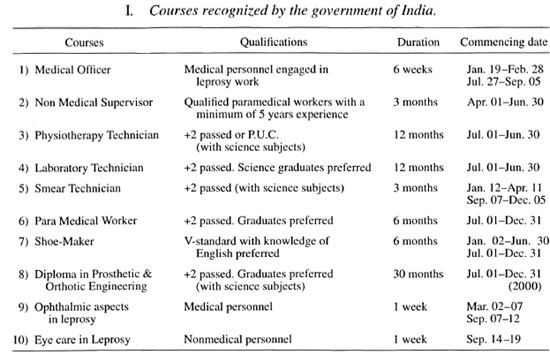
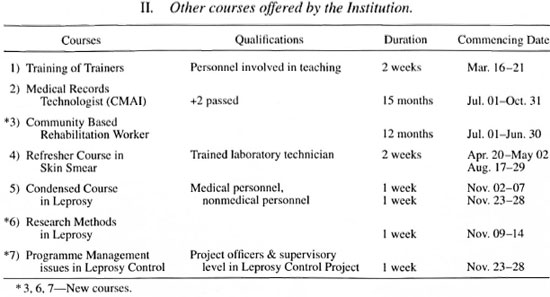
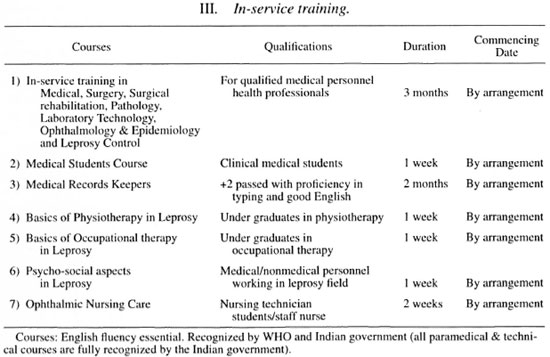
How to Reach Karigiri: Karigiri is situated about 130 km west of Chennai (Madras), which is connected to all the major cities of India by air, train and road. From Chennai Airport the fare for taxi is approximately Rs. 800/-. Route = Ranipet → Tiru valeam → Sevoor → Karigiri Hospital. There are also many buses which operate between 05:00 hrs and 22:00 hrs from Chennai to Vellore. From Vellore take any taxi or auto which costs Rs. 150/- and Rs. 100/-, respectively, or else you can take a prepaid taxi or electric train to the city railway station (Central Railway Station) about 20 kms away from airport. From there take any train to Katpadi Railway Station (13 kms away from Karigiri). From Katpadi to Karigiri an auto will cost Rs. 100/-. If you want to be met at Katpadi or at Chennai Airport, please let us know well in advance.
Mailing Address: Director or Registrar, Training Unit, Schieffelin Leprosy Research & Training Centre, Karigiri 632 106, Vellore District, Tamil Nadu, India.
Contact Institution: Mr. T. Jayarajan, Registrar, Schieffelin Leprosy Research & Training Centre, Karigiri 632 106, Vellore District, Tamil Nadu, India.
Tel: 91-(0)416-74227, 74229, 74251, 74221 (Director); Fax: 91-(0)416-74274, 25035,32103,32788.
20th Biennial conference of IAL at Bhopal. The 20th biennial conference of the Indian Association of Leprologists (IAL) was held at the Gandhi Medical College, Bhopal, Madhya Pradesh, India, during 28.11.1997 to 30.11.97. It was attended by about 300 delegates working in the field of leprosy from India and abroad. The conference was preceded by two symposia: Relevance of research in the present scenario and Leprosy scenario in low endemic areas. These were held on 27.11.97 and were chaired by B. R. Chatterjee and B. F. A. M. Peters, respectively.
The Conference was inaugurated by S. K. Noordeen, Director, Action Programme for Elimination of Leprosy, WHO, Geneva. Dr. Noordeen also delivered the keynote address on "Whither Leprosy?" In addition there were guest lectures on: Problem of Disability by H. Srinivasan, Vaccine Against Leprosy by B. R. Chatterjee, and Pathology of Nerve in Leprosy by V. P. Shetty.
There was overwhelming response of the scientists working in various aspects of the disease, as evidenced by the number of abstracts received. The scientific committee accepted 80 papers for oral presentation and another 56 for poster. The scientific deliberations were conducted through 10 well organized sessions. There were sessions on microbiology and biochemistry, immunology and pathology, clinical leprosy, treatment, reconstructive surgery, prevention of disability, epidemiology and control, and social aspects. The Chairpersons for these sessions were K. V. Desikan, U. Sengupta, R. S. Mishra, R. Ganapati, V. V. Dongre, Bhusan Kumar, M. D. Gupte, S. Solomon and B. L. Sharma. The guest lectures were chaired by J. A. Ponniah and V. P. Bharadwaj.
In view of the emerging interest on single lesion leprosy there was a special and longer session on this subject in which S. K. Noordeen and R. Ganapati emphasized the need for a single dose of multidrug for this type of the disease and briefed the results of the multicentric study. This was followed by the presentations of the individual principal investigators of the multicentric study. Then there was a floor discussion through which V. M. Katoch, Diana Lockwood, G. Ramu, K. V. Desikan, Bhusan Kumar, M. D. Gupte debated on the subject. Through the discussions individual opinions, including the reservation and caution that need to be taken are voiced. The session was chaired by H. Srinivasan.
There was also an award session to evaluate the entries for two awards - one for the best publication and the other for the best presentation by the younger scientists. The session was chaired by K. V. Desikan. The judges were B. R. Chatterjee, V. P. Bharadwaj and the chairman himself. The award for best publication went to Dr. R. J. De Britto and for best presentation to Anurag Tiwari. The awards were courtesy Acworth Leprosy Hospital Research Society, Mumbai.
But for the minor disruptions due to delay inauguration and untimely rain, the whole conference went well. During their stay the delegates enjoyed the warmth of Bhopal hospitality in plenty. For everything special thanks goes to M. P. Dwivedi, Organi g Secretary, to S. C. Tiwari, HOD PSM and chairperson reception, and B. L. Sharma, State Co-ordinator, DANLEP. The latter's presence could be felt everywhere everytime. The organizers made this conference a special one by facilitating three eminent sons of the soil, Dr. G. Ramu, Dr. S. K. Noordeen and Dr. D. P. Benerjee for their outstanding contribution in the field of leprosy. As a generous gesture mementoes in the form of silken scarf imprinted with health education messages were presented to all presenters and chairpersons.
Finally, a line about the evening entertainment where the traditional folk dances from different parts of MP kept the delegates spellbound. Of all the items the Pandwani performances of Ms Ritu Verma could hardly be erased from the memory spool of the viewers.
Hopefully all delegates had an uneventful departure and safe journey back home. - D. Porichha, Hon. Secretary, Indian Association of Leprologists
IAL elects new officers. The Indian Association of Leprologists (IAL) held its general body meeting on 29.11.1997 at Gandhi Medical College, Bhopal, with Dr. B. R. Chatterjee on chair. After a brief welcome remark by the President, Hon. Secretary Dr. B. N. Reddy presented the report on various activities undertaken during the 2 years' tenure, followed by the presentation of audited accounts by the Treasurer Sri S. S. Naik.
Thereafter two resolutions one relating to election by postal ballot and the other for inclusion of postgraduates of Social Sciences as members were moved in the house and were voted out. The third resolution for increase of ordinary and life membership fee to Rs. 100 and Rs. 1000, respectively, was passed.
The general body was also elected the central council members for the term 1998-1999, and Dr. K. V. Desikan, presiding officer, declared the following members as elected: President: Dr. J. A. Ponniah, Consultant, WHO/NLEP, Darpan, 84/2 Parvati, Sahakarnagar No. 2, Pune 411009: Vice Presidents': Dr. V. H. Jadhav and Dr. M. A. Arif; Hon. Secretary: Dr. D. Porichha, Medical Centre, Parliament House Annexe, New Delhi 110001; Treasurer: Dr. V. Ramesh, Medical Centre, Parliament House Annexe, New Delhi 110001; Central Council Members: Drs. G. Rajan Babu, C. R. Revankar, M. P. Dwivedi, N. Manimozhi. Mr. S. S. Naik, Drs. Amarkant Jha Amar, V. V. Pai, V. V. Gurunath Babu, B. P. Ravikumar, Bhushan Kumar, U. Seneupta, P. N. Gupta, Inder Parkash, P. K. B. Patnaik.
Then the charges of the august office was handed over to the new council. Deep appreciation was recorded to the outgoing central council and the Organizing Secretary of Bhopal Conference, Dr. M. P. Dwivedi.
The generous offer of hosting the next Biennial Conference at PGI Chandigarh by Dr. Bhusan Kumar, Prof, and HOD, STD and leprosy was accepted by the house. The meeting ended with a vote of thanks to the chair. - D. Porichha, Hon. Secretary, Indian Association of Leprologists.
Training for the handicapped in photography by VRC. The Vocational Rehabilitation Centre (VRC), an institution run by the Ministry of Labor, Government of India, in Mumbai, is conducting a training program in photography for handicapped persons including cured leprosy patients in collaboration with the Bombay Leprosy Project (BLP), a nongovernmental organization working with the aim of integrating leprosy patients with other handicapped.
A review of this 6-month training course was held on 20 October 1997 at the VRC. On this occasion, Mr. R. Narasimham, Sr. Superintendent of VRC, said that he is always concerned about the plight of leprosy patients since his studenthood and assured to provide the best services through VRC. The experience of VRC shows that leprosy patients receiving training in a nonleprosy institution contribute to abolish stigma.
Dr. R. Ganapti, Director, BLP, while applauding the efforts made by the VRC to bring the cured leprosy persons into the mainstream of their vocational training for handicapped, expressed the need for offering such training particularly in professions are assuming importance in the modern age of advancing technology. The trainees who undergo practical training on the technical aspects of medical and commercial photography will promote BLP's novel concept of harnessing the skills of the handicapped even in areas of research. These patients will assist the "documentation cell" of the project and thereby augment research in leprosy.
Mr. V. Y. More, Instructor, VRC; Mr. T. P. Mirajkar, Rehabilitation Officer, BLP and Mr. P. Narayanasamy, Manager, BLP, participated in the review. - Press release received from R. Ganapati
Myanmar. Third Independent Evaluation of the Leprosy Elimination Program, 4-18 November 1997. The Third Joint WHO and Union of Myanmar Independent Evaluation of the Leprosy Elimination Program in Myanmar took place between 4 and 18 November 1997, in order to assess progress and to identify measures to accelerate the elimination of leprosy as a public health problem. The terms of reference were to: 1) assess progress in the leprosy program since 1990, with special focus on the year 1993, and to identify critical components in need of strengthening; 2) validate reported data, including patient diagnosis, classification and multiple drug therapy (MDT) services; 3) assess the level of awareness in the community and in leprosy patients; 4) ascertain the level of competence, contribution and commitment of health staff involved in planning, management and delivery of leprosy elimination services at different levels and 5) to identify priority areas/activities needed to accelerate the attainment of the goal of elimination of leprosy at national and subnational levels by the year 2000.
Six out of 7 divisions and 2 out of 7 states were selected for field visits, to include 25 districts and 46 townships, to be examined by five teams each composed of two national experts and one external expert. The latter were: S. Barua (Japan), R. Day (Indonesia), A. C. McDougall (United Kingdom), J. O. Simon (India) and L. R. Talukder (Bangladesh), all invited by the South-East Asia Regional Organization (SEARO) of WHO in New Delhi as temporary advisers.
Teams were dispatched to cover both moderate and (previously) high-endemic areas in various parts of the country in order to obtain information at state/division, township and rural health center levels. This was recorded in detail on prepared questionnaires from which data were pooled and analyzed on return to the Department of Health in Yangon (Rangoon). The areas under examination inlcuded wellestablished programs in which MDT had been started in 1989, together with those of lower prevalence in which it had been introduced as recently as 1995/1996.
All participants reported good progress in leprosy control generally, with strong political commitment and high levels of motivation in both vertical and basic health care staff. The decision to fully integrate leprosy services into the primary health care program in mid-1991 has proved successful, including considerable input from midwives in the delivery of MDT to patients in or near their homes. In order to ensure maximum coverage to cases so far undetected, in the time available before the year 2000, participants agreed that there is a need to: 1) expand information, education and communication (IEC) activities, including the development of posters in adequate numbers and other material in Myanmar (Burmese) for the general population (which has a literacy level of 83%) and 2) develop innovative approaches for ethnic and border populations who, in contrast, are illiterate in both Myanmar and their own languages. Leprosy Elimination Campaigns (LEC), already established in 16 areas of the country, may be extended to cover the whole of Myanmar in 1998.
Myanmar is one of the countries which contributes to 91% of the world problem of leprosy. At the beginning of 1997, WHO reported 18,758 cases registered, with 100% MDT coverage; a cumulative total of 148,982 cases cured by MDT; 6935 cases detected in 1996. The estimated number (1996) of individuals presenting disabilities due to past or present leprosy is 41,000, emphasizing the continuing need to strengthen activities in disability prevention and management on a considerable scale, including self-care and community-based rehabilitation (CBR).
In the early years of the history of leprosy in Myanmar, the country was confronted with an enormous problem, one of the worst in South-East Asia. In 1973, no fewer than 245,000 cases were registered and when the main project started prevalences of 40 per thousand, or even higher were not exceptional in school surveys in central Myanmar. Today, surveys yield extremely few cases. The elimination of leprosy will be achieved at national and many subnational levels in the near future, but there is a need to maintain the existing contribution of the basic health services, together with a vertical element down to township level, at least until the year 2000, and possibly longer. - A. C. McDougall
U.K. "Sustaining Leprosy Related Activities - Guidelines for Responding to Change "
new ILEP publication. The introduction of multidrug therapy (MDT) for the treatment of leprosy has radically changed the extent and nature of the leprosy problem. Millions of leprosy patients have now been successfully treated. However, leprosy is a continuing problem, since leprosy cases occur each year. It is therefore essential to sustain leprosy services. Yet the structure and size of these services must change. In many countries, this is already happening, combining with other disease control programs and integrating into primary health care services. Also, financial responsibilities are bound to shift toward governments and local nongovernmental organizations (NGOs). It is vital to carefully assess the need and to plan for these changes. These Guidelines are the outcome of a workshop organized by the International Federation of Anti-Leprosy Associations (ILEP) and the Netherlands Leprosy Relief Associations (NSL) held in Amsterdam, The Netherlands, in September 1996. During the workshop, leprosy experts and health planners discussed various issues and aspects related to the improvement of the sustainability of leprosy services. The resulting guidelines are intended to facilitate this process. They are directed to program managers and policy makers and follow a stepwise and participatory planning approach.
The booklet is divided into three parts. The first part deals with the necessary situational analysis of existing services. Part two describes the possible planning steps in the process of organizational change. The last section describes useful strategies and mechanisms in the implementation of the desired change. The booklet is available, free of charge to personnel active in this field, from: International Federation of Anti-Leprosy Associations (ILEP), 234 Blythe Road, London W14 OHJ, U.K. Fax: 44/171 371 1621; E-mail: ilep@ilep.org.uk - Materials from Sarah Lacey
U.S.A. Sth International Congress on Infectious Diseases. The 8th International Congress on Infectious Diseases will be held May 15-18, 1998 in Boston, Massachusetts, U.S.A. For details contact: Norman R. Stein, Executive Director, International Society for Infectious Diseases, 181 Longwood Avenue, Boston, MA 02115, U.S.A. Tel: 1-617-277-0581; fax: 1-617-731-1541; email: isidbis@aol.com.
9th Annual Tropical Health Update meeting in New Orleans. The 9th Annual Tropical Health Update conference will take place in New Orleans, Louisiana, in May of 1998. For details contact: Danielle Blanchard, Tulane University Medical Center, Office of Continuing Education, 1440 Canal Street, Suite 1611, New Orleans, LA 70112-2750, U.S.A. Tel: 1-504-588-5466; fax: 1-504-584-1779.
U.S. leprosy cases in 1996. According to the Centers for Disease Control and Prevention, there were 112 new cases of leprosy diagnosed in 1996 in the U.S.A. California with 48 had the most new cases, followed by Texas with 29, Hawaii with 15, New York with 5 and Massachusetts with 4. This is similar to the range of new case detections during the 1960s and early 1970s prior to the increased influx of Indo-Chinese refugees.- MMW 45 (1997).